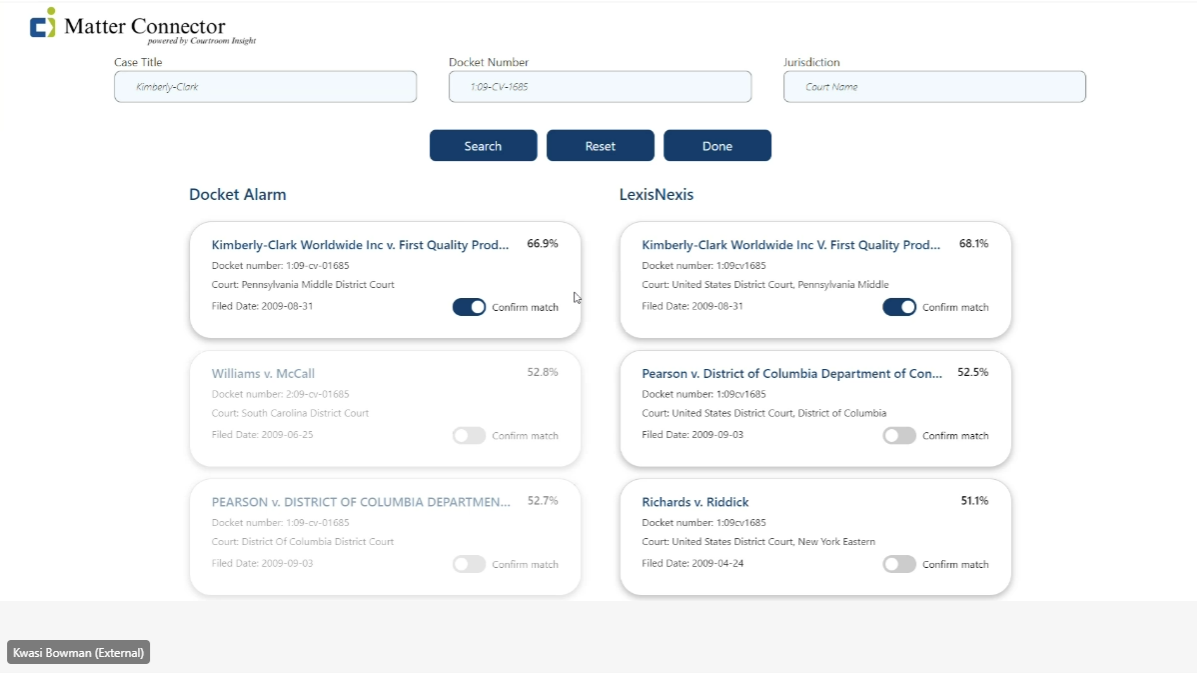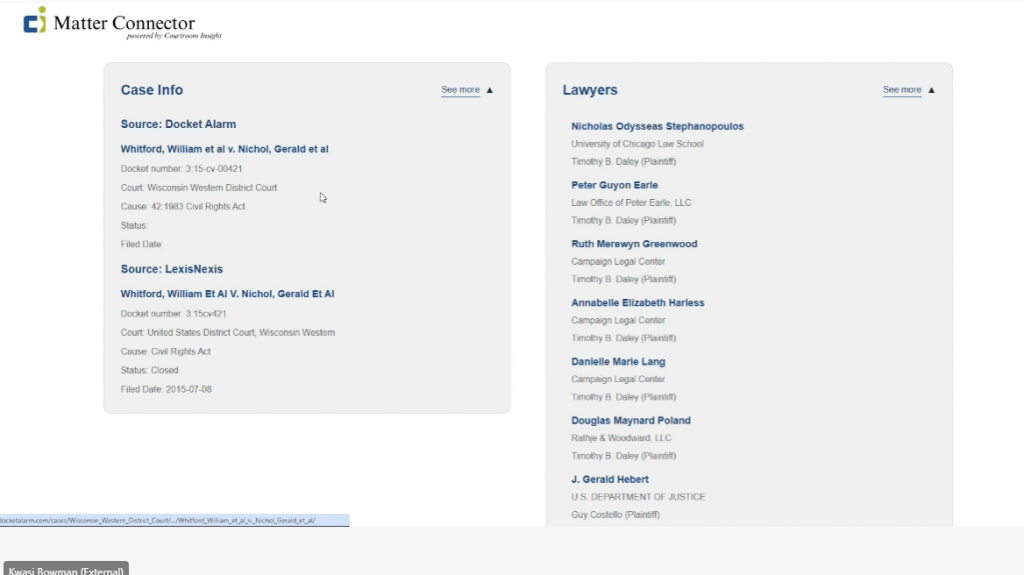Courtroom Insight today launched Matter Connector, a product that delivers normalized docket data from multiple sources to the knowledge management platform Litera Foundation and to other law firm systems.
Matter Connector enables law firms to centralize docket data from major providers, such as LexisNexis, Lex Machina and vLex Docket Alarm, through one unified connector.
Using unique identifiers, Matter Connector pulls data from disparate docket providers, normalizes it and enriches it to make it compliant with the standards of the Standards Advancement for the Legal Industry Alliance (SALI).
Firms are also able to link and map data from Courtroom Insight’s profiles of judges, lawyers, experts, and neutrals.
As of today, Courtroom Insight is offering Matter Connector as a standalone product, according to CEO Mark Torchiana. For firms that purchase an API from one of Courtroom Insight’s docket-data partners, Courtroom Insight will manage those credentials and add this service on top of the API feed.
Courtroom Insight developed Matter Connector through a partnership with the law firm Troutman Pepper and the Foundation product team at Litera.
Carrie Remhof, senior firm intelligence manager at Troutman Pepper, described Matter Connector as an innovative tool that seamlessly integrates public docket data with her firm’s internal systems.
“This groundbreaking solution addresses a long-standing industry challenge and highlights our dedication to harnessing enriched data for insightful decision-making,” Remhof said. “The Matter Connector not only optimizes our processes but also places us at the cutting edge of firm intelligence, shaping the future of legal practice.”
Torchiana said that Matter Connector’s ability to normalize legal data and insights from multiple data sources is a game changer for legal organizations.
“With our Matter Connector, Courtroom Insight ensures that clients are accessing and working with accurate and reliable data — which is essential for research, case preparation, and legal strategy,” he said.
Normalizing and Enriching Docket Data
In advance of today’s launch, I met with Remhof and Torchiana for a briefing and demonstration, which was also joined by by Max Polinski, product manager for Foundation at Litera, and Kwasi Bowman, product manager at Courtroom Insight.
They said that development of Matter Connector came about at the suggestion of Remhof, who was looking for a way to connect external docket data into Foundation.
But all agreed that what was needed was not just a simple connector to plug a single docket feed into Foundation, but rather something that would take data from multiple docket feeds and normalize and enrich it to make it as seamless as possible.
For Remhof, the pain point was that each vendor of docket data wanted to build its own Foundation integration, which would leave Remhof having to configure it and normalize the data.
“The magic that Mark and his team are bringing is that they are normalizing that external data, getting it into shape,” Remhof said.
She then worked with Polinski, with whom she formerly worked with as a colleague at Foundation before she joined Troutman Sanders, to further shape how that data should be configured in Foundation.
Remhof said her firm had already integrated Courtroom Insight, so it had information such as Courtroom Insight’s profiles of expert witnesses.
“But the piece I was missing was how that expert attaches back to my clients and matters, right. So with Mark having built this, I can now see that this expert was on this matter and I can show the full picture.”
How It Works
So far, the connector works for docket data from Docket Alarm and LexisNexis, but the plan is to add all major providers of docket data.
On the front end, a user provides the case title, docket number and jurisdiction, and the connector matches the information across the different data sources, normalizing the data and returning the results from all the sources.
It provides a list from all the sources of all the cases that may match the input, also providing a ranking of the system’s confidence in the matches.
In an example during the demonstration, difference sources showed the same case’s docket numbers in different formats, showing why the normalization is important.
While the connector is now relying on humans to verify the matches, Torchiana said that they are working on machine learning that will allow the process to be more automated.
“What we intend to do is actually proactively pull all Troutman cases and do this on an ongoing basis,” he said. “So every single day, this will be automatically populated, this will automatically feed through the system and then ultimately back into Foundation.”
Once the case has been matched, it can be enriched with people information from Courtroom Insight, including automatically tagging the lawyers, judges and experts who are involved in the case. The user can also add tags manually.
Because the lawyers on cases change over time and dockets do not always accurately represent those changes, Courtroom Insight has developed a way to track those changes over time, to ensure its tagging is accurate.
“So the wealth of 500,000 experts from our database will be automatically tagged into these documents and then pushed into the system of our clients so they can have all this people data as well,” said Bowman.
Courtroom Insight also enriches the data with SALI tags to identify practice areas and industries in a consistent way.
A Feed for Data Lakes
Although the connector was developed in partnership with Foundation, the data can be used with other law firm systems. Remhof says she first puts the data into her firm’s master data warehouse. From there, they can leverage the data in Foundation, but also in systems such as Microsoft Power BI and Tableau.
“When I bring in information about the docket — what are the motions, what is the outcome, who are the participants, who’s the plaintiff and who’s the defendant — getting that data into Foundation advances Foundation for us,” Remhof said.
“It gives information to our attorneys and our business development team to be able to say, ‘What’s the duration of this type of case, what’s an exemplar matter of what we’ve done to sue for pricing a new matter?'”
Remhof also likes the flexibility of it. Until now, if she wanted to change her docket vendor, it would not be that easy to switch out the API.
“Now that it’s easy to switch out an API at any point in time,” she said, “I’m not so beholden to the docket vendor.”
 Robert Ambrogi Blog
Robert Ambrogi Blog
